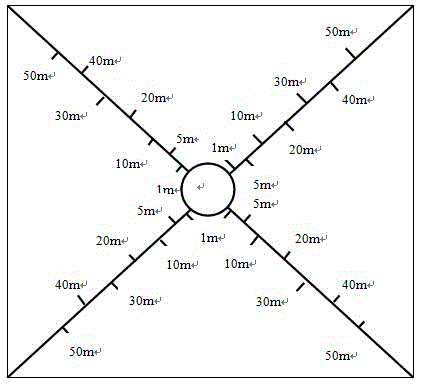Simple method for determining drift rate and drift distance of transgenic cotton
A drift distance and genetically modified technology, which is applied in the field of agricultural applications, can solve problems such as the method of drift rate of transgenic cotton that has not yet been found, and achieve good operability, improve the level of supervision, and intuitively judge the effect
- Summary
- Abstract
- Description
- Claims
- Application Information
AI Technical Summary
Problems solved by technology
Method used
Image
Examples
Embodiment 1
[0015] Such as figure 1 As shown, in a cotton field with an area of 100m×100m, the transgenic cotton to be tested was planted in a circle with a central diameter of 5m, and control cotton was planted around the circle. When cotton is harvested, 10 cotton plants are selected in concentric circles at the distances of 1m, 5m, 10m, 20m, 30m, 40m, and 50m from the cotton to be tested in the four directions of east, south, west, and north, respectively. Pick 3 bolls of cotton according to the top, middle and bottom respectively, and mark them.
[0016] The harvested samples are hung to dry and ginned separately to get the cotton seeds; in the second year when the temperature is suitable, sow the cotton seeds collected from different parts of each point as a small plot, and mark it well, so that intensive sowing can be carried out, and the cotton seeds can be planted according to the routine Methods The cotton fields were managed, and when the cotton bloomed, the number of cotton ...
Embodiment 2
[0019] Such as figure 1 As shown, in a cotton field with an area of 100m×100m, the transgenic cotton to be tested was planted in a circle with a central diameter of 5m, and control cotton was planted around the circle. When cotton is harvested, 10 cotton plants are selected in concentric circles at the distances of 1m, 5m, 10m, 20m, 30m, 40m, and 50m from the cotton to be tested in the four directions of east, south, west, and north, respectively. Pick 5 cotton bolls according to the top, middle and bottom of the cotton, and mark them.
[0020] The harvested samples are hung to dry and ginned separately to get the cotton seeds; in the second year when the temperature is suitable, sow the cotton seeds collected from different parts of each point as a small plot, and mark it well, so that intensive sowing can be carried out, and the cotton seeds can be planted according to the routine Methods The cotton fields were managed, and when the cotton bloomed, the number of cotton pl...
Embodiment 3
[0023] Such as figure 1 As shown, in a cotton field with an area of 100m×100m, the transgenic cotton to be tested was planted in a circle with a central diameter of 5m, and control cotton was planted around the circle. When cotton is harvested, 10 cotton plants are selected in concentric circles at the distances of 1m, 5m, 10m, 20m, 30m, 40m, and 50m from the cotton to be tested in the four directions of east, south, west, and north, respectively. For cotton, 10 cotton bolls are picked respectively according to the top, middle and bottom, and marked.
[0024] The harvested samples are hung to dry and ginned separately to get the cotton seeds; in the second year when the temperature is suitable, sow the cotton seeds collected from different parts of each point as a small plot, and mark it well, so that intensive sowing can be carried out, and the cotton seeds can be planted according to the routine Methods The cotton fields were managed, and when the cotton bloomed, the numb...
PUM
 Login to View More
Login to View More Abstract
Description
Claims
Application Information
 Login to View More
Login to View More - R&D
- Intellectual Property
- Life Sciences
- Materials
- Tech Scout
- Unparalleled Data Quality
- Higher Quality Content
- 60% Fewer Hallucinations
Browse by: Latest US Patents, China's latest patents, Technical Efficacy Thesaurus, Application Domain, Technology Topic, Popular Technical Reports.
© 2025 PatSnap. All rights reserved.Legal|Privacy policy|Modern Slavery Act Transparency Statement|Sitemap|About US| Contact US: help@patsnap.com

